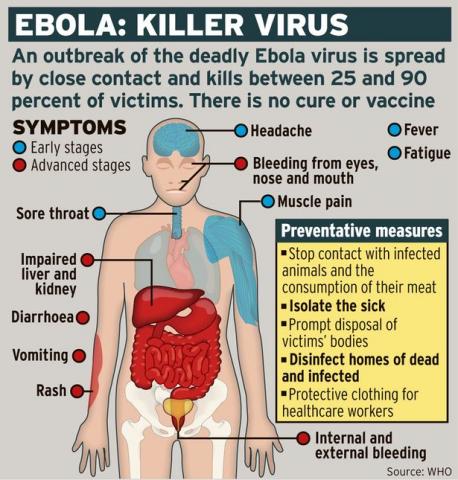Since Peter Piot and his team finished their Ebola investigations in Yambuku, in 1976, other scientists and medical researchers have been working hard to learn more about this deadly disease. Despite worldwide efforts:
- There remains no cure; and
- There is no commercially available vaccine.
Treatment consists of early intervention to lower the fever and support the body’s loss of fluids.
What about preventing Ebola altogether? Peter Piot says not much has changed since his visit to Yambuku in 1976:
Soap, gloves, isolating patients, not reusing needles and quarantining the contacts of those who are ill - in theory it should be very easy to contain Ebola.
That, however, is often easier said than done. The same is true of social distancing, which is not always possible (despite best intentions to avoid spread by close contact).
Furthermore ... people who become ill, and their family members who try to support them, do not always tell medical authorities about what is happening.
Ebola can have a stigmatizing effect which people want to avoid. They may not realize that failing to seek help will likely lead to death.
Sometimes cultural beliefs cause community members to believe that witchcraft causes the illness. Perhaps remembering what happened in Yambuku, some areas stricken by the Ebola virus become hostile toward medical workers.
As Piot says, of Ebola today:
We shouldn't forget that this is a disease of poverty, of dysfunctional health systems - and of distrust.
It is also a disease which appears to be impacting gorillas. In her 2008 work, entitled Disease: The Extraordinary Stories Behind History's Deadliest Killers, Dr. Mary J. Dobson reports that researchers think thousands of gorillas, living in the wild, have succumbed to Ebola:
While conservationists are concerned about over-hunting and the threat to wildlife, epidemiologists are worried about the risk of infected wild animals spreading diseases like Ebola to the human population, as well as the risk of Ebola for populations of great apes.
Researchers in the region straddling the border between Gabon [a former notorious slave-trading place] and the Republic of the Congo believe that some 5000 gorillas have been wiped out by Ebola, with suggestions that the disease is now passing from gorilla to gorilla through direct contact. (See Dobson, at page 189; see,also, the following image online via the Australian Broadcasting Company.)

In 2014, a massive Ebola outbreak in western-African countries caused not only sorrow and anguish in those lands, but also worldwide fears that the deadly virus would migrate around the globe. Treatment and prevention in 2014, however, remained much the same as it was during the original 1976 outbreak.
Cases of Ebola were also present, during 2014, in the Democratic Republic of the Congo (formerly Zaire) where the 1976 epidemic occurred. Representatives of the CDC (Centers for Disease Control), however, believe those cases are unrelated to the outbreak in West Africa.
As of mid-November, 2014, the CDC and WHO (the World Health Organization) reported the following numbers of Ebola cases and resulting deaths:
- Total Cases: 14413
- Laboratory-Confirmed Cases: 8920
- Total Deaths: 5177
Does the future hold positive developments in the battle against Ebola?
What do scientists think about more research on the illness?
Is additional research likely to lead to a better understanding of the virus, which could thereafter lead to a preventive vaccine?
Let’s put those questions to some of the world’s leading Ebola researchers.


 Back
Back
 Next Chapter
Next Chapter

 Back
Back
 Next Chapter
Next Chapter
